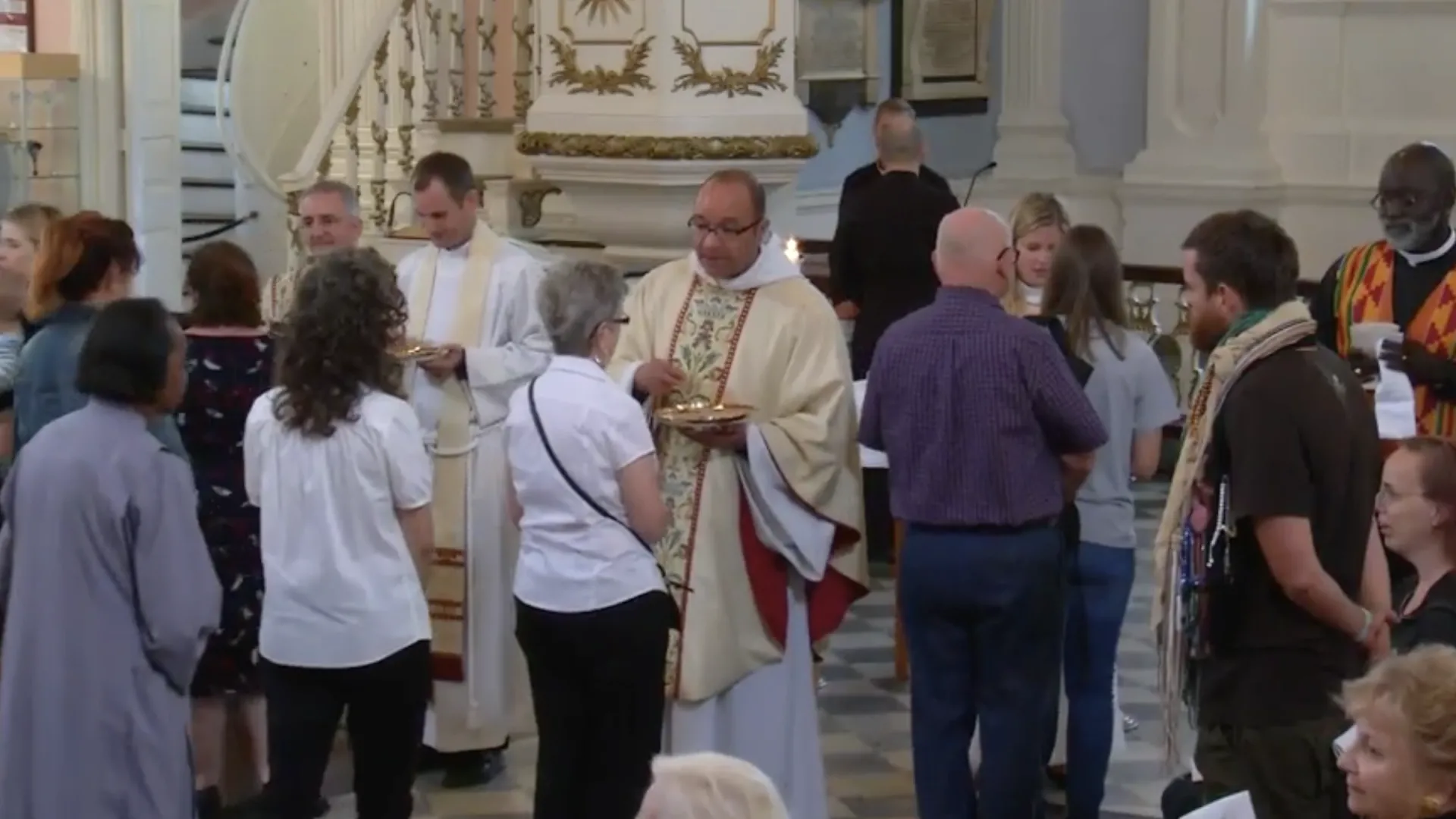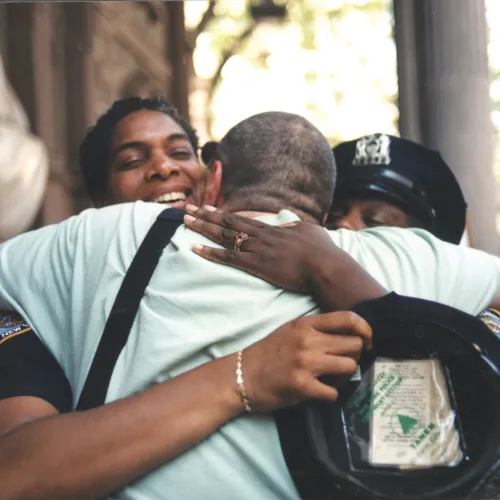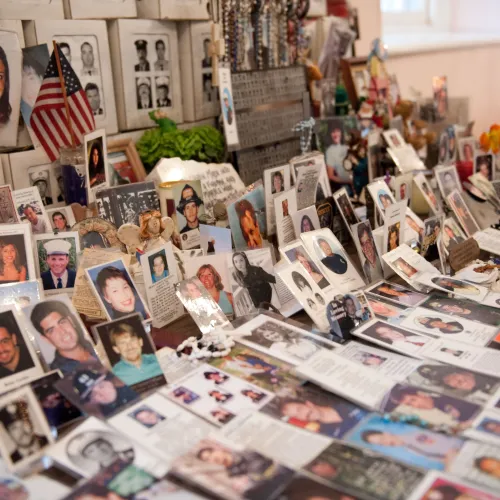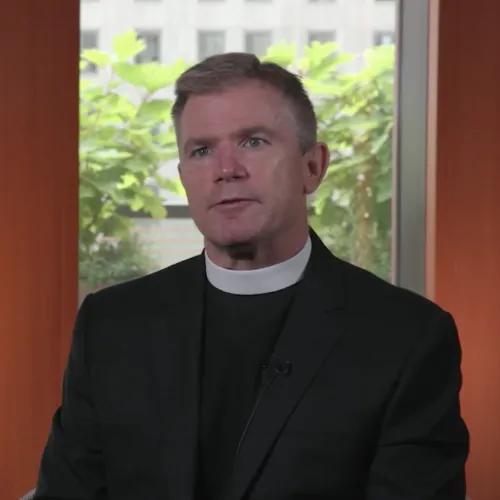9/11

As a community with deep roots in Lower Manhattan, Trinity Church will never forget those who lost their lives on 9/11.
While St. Paul’s Chapel, located steps away from the World Trade Center site, was not damaged in the attacks, it became a site of refuge and respite for thousands of rescue workers and volunteers who selflessly served the community.
Every year, we ring the Bell of Hope during a September 11 worship service to remember and pray for all victims of terrorism and mass shootings. “Trinity Church [became] a beacon of hope and healing in an extraordinarily difficult time,” says Trinity’s vicar, the Rev. Michael Bird, who volunteered at St. Paul’s Chapel in the aftermath of the attack. “These commemorations are an important reminder of how we all came together.”
“We will always be here.” The Rev. Phil Jackson shares his 9/11 remembrance.
The Chapel That Stood
On September 12, the Rev. Lyndon Harris, then a priest on the clergy staff at Trinity and St. Paul’s, arrived at St. Paul’s Chapel expecting major damage. He was amazed to find that not even a pane of glass was broken, although the exterior of St. Paul’s and its churchyard were covered in debris. After engineers inspected the building and pronounced it sound, cleanup began.
As recovery work started at the World Trade Center site, hundreds of rescue workers came to Lower Manhattan to search for survivors and begin sorting through the ruins. Slowly at first, rescue workers, police, and firefighters stopped by the chapel to rest and wash up. Because long, exhausting shifts prevented many workers from going home, the chapel opened its doors so that they could rest. Shortly after, an outdoor grill was fired up, and volunteers began to serve food to hungry rescue and recovery workers.
Volunteers from Seamen’s Church Institute arrived on September 15 with food, clothing, and other supplies. Labor of Love, an Episcopal relief ministry based in Asheville, North Carolina, arrived on September 21. The volunteers were all experienced in disaster relief and skilled in offering support and guidance during a crisis.
During all hours of the day and night, rescue and recovery workers staggered through the gates of the chapel. Hungry and weary, weighed down with gear, wearing boots half-melted from the fiery ash, they knew that St. Paul’s was a place they could rest for a few hours before returning to the pit.
In the first three months after September 11, more than 3,000 workers passed through the chapel’s gates. Police officers, Port Authority workers, firefighters, National Guardsmen, construction and sanitation crews, engineers and technicians found their way to St. Paul’s. The recovery workers were changed by what they volunteered to do at Ground Zero, but they also were changed by the ministry offered to them by St. Paul’s and its volunteers.
People Pitch In
In the days immediately following September 11, New York residents went to grocery and drug stores and bought supplies for the rescue efforts. Soon, supplies and memorials covered every inch of the chapel. Cots, massage tables, and food stations lined the perimeter. Volunteers crammed tables with clothing, shoes, and toiletries. Long tables were piled high with fresh fruit. Boxes overflowed with candy, cookies, chips, energy bars, gum, and cigarettes.
Volunteers from all walks of life and all parts of the country signed up for 12-hour shifts to help put the workers’ bodies and souls back together so they could continue their grueling tasks at Ground Zero. Chiropractors and massage therapists soothed the workers’ aching backs. Podiatrists used George Washington’s presidential pew to patch and stitch tired, injured feet. On the chapel’s grand piano, musicians played Amazing Grace and Danny Boy at least once a day. Chaplains were organized on a round-the-clock schedule. What had started as a place for workers to simply recover from their labor at Ground Zero became a place filled with love, hope, and support: a place where recovery began to be a possibility.
Faith Brings People Together
Despite hosting hundreds of workers each day, St. Paul’s Chapel never lost sight of its role as a house of worship. Workers and volunteers from different backgrounds and faiths participated in the daily Eucharist.
Worship also went beyond the chapel’s Episcopal prayers and services as visitors shared their individual practices, including a Japanese Shinto service in the cemetery, a Native American peace-pipe ceremony, a Baha’i prayer, a Hanukkah service, a Buddhist chant, a Mennonite choir performance, and an Islamic chant.
More than 300 clergy volunteered to cover the daily liturgy and sooth those immersed in the tragic work at Ground Zero. In the pews, workers whispered their stories and unburdened their minds as clergy spent sleepless nights trying to meet their needs. Volunteers and workers cried, prayed, and found solace in the communal warmth of St. Paul’s.
Messages From Around the World
After September 11, thousands of visitors transformed the wrought-iron fence surrounding St. Paul’s Chapel into a spontaneous memorial. They posted banners, posters, personalized t-shirts, flags, letters, religious items, and many other mementos that held significant personal meaning.
As people around the nation and the world learned about the ministry at St. Paul’s Chapel, large banners with messages of love and solidarity for New York and the recovery workers began to arrive at the chapel. Support and encouragement poured in from students, cities, civic groups, and individuals. Thousands of strings of multi-colored origami peace cranes, known as Senbazuru, were sent from school children and other groups throughout Japan, including survivors of the bombings of Hiroshima and Nagasaki.
The letters, drawings, banners, and peace cranes were taped to the pews and columns and displayed throughout the chapel for workers to see and read.
A Routine Begins to Return
On February 13, 2002, Ash Wednesday, St. Paul’s Chapel opened to the public for Imposition of Ashes, a Christian ritual that has been practiced since the 9th Century. A continuous stream of people entered the chapel to have their foreheads marked with the sign of the cross, using ashes prepared by burning palm leaves from the previous year’s Palm Sunday celebrations. Staff and volunteers tried to maintain the sanctity of the rescue workers’ space with signs posted outside the chapel: Imposition of Ashes to the left; rescue workers to the right.
That March, Trinity Church decided to reopen the chapel to the public. But after receiving more than a thousand letters, petitions, and press coverage, Trinity announced that it would not end its ministry until the recovery work was completed at Ground Zero.
In May 2002 a closing service was held at St. Paul’s for the workers. Rafe Greco, an ironworker who often slept at St. Paul’s, said he and his colleagues would “never have been able to do it without St. Paul’s Chapel.” Tom Geraghty, a construction worker whose sister-in-law was a victim of the attacks, said he “cursed God” until he found the chapel. He said St. Paul’s was simultaneously a “kitchen, a therapist’s couch, a little stage on Broadway, a bedroom, an art gallery, and a doctor’s office.” It was “a place to get my thoughts and emotions back on track.”
At noon on June 2, 2002, there was a last, private service for the workers, and then it was time to end the chapel’s unexpected ministry. A small group of volunteers removed the banners, posters, and cards from the walls, cataloged everything, and wrapped it all carefully.
During the nine months of ministry, St. Paul’s had become much more than a place just to eat and sleep. It had become a community dedicated to healing, and a symbol of recovery and hope.









